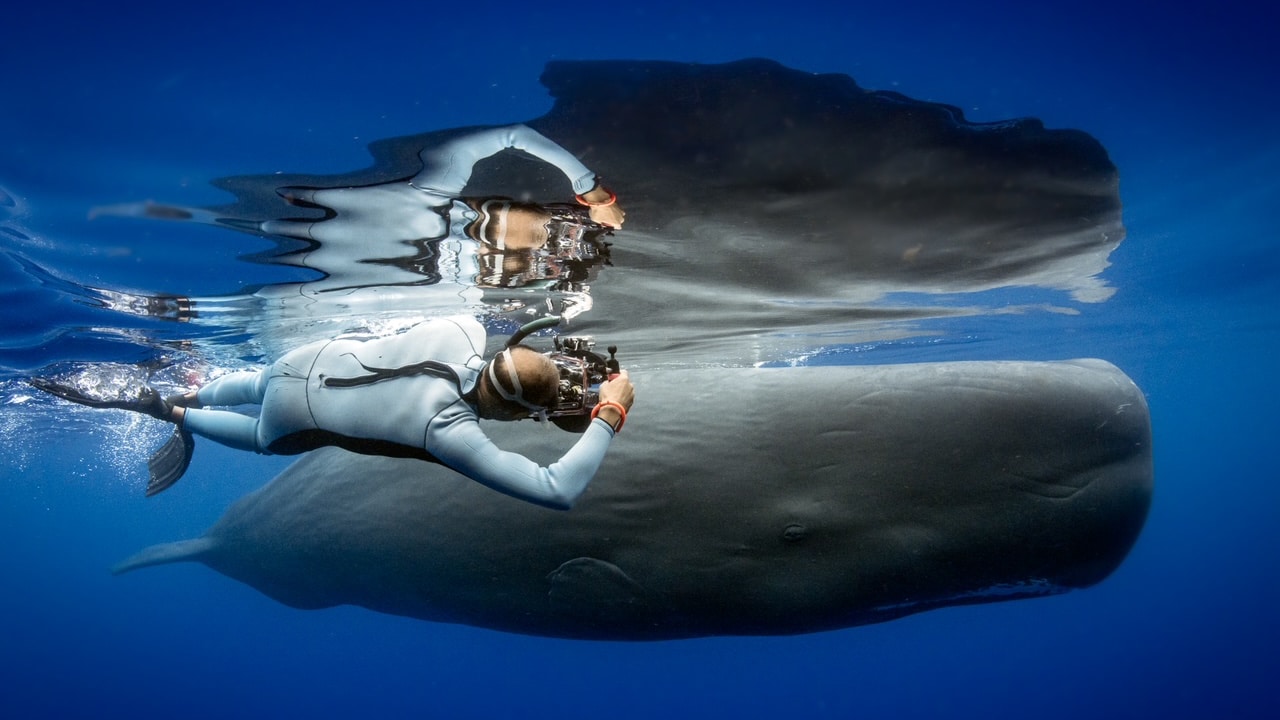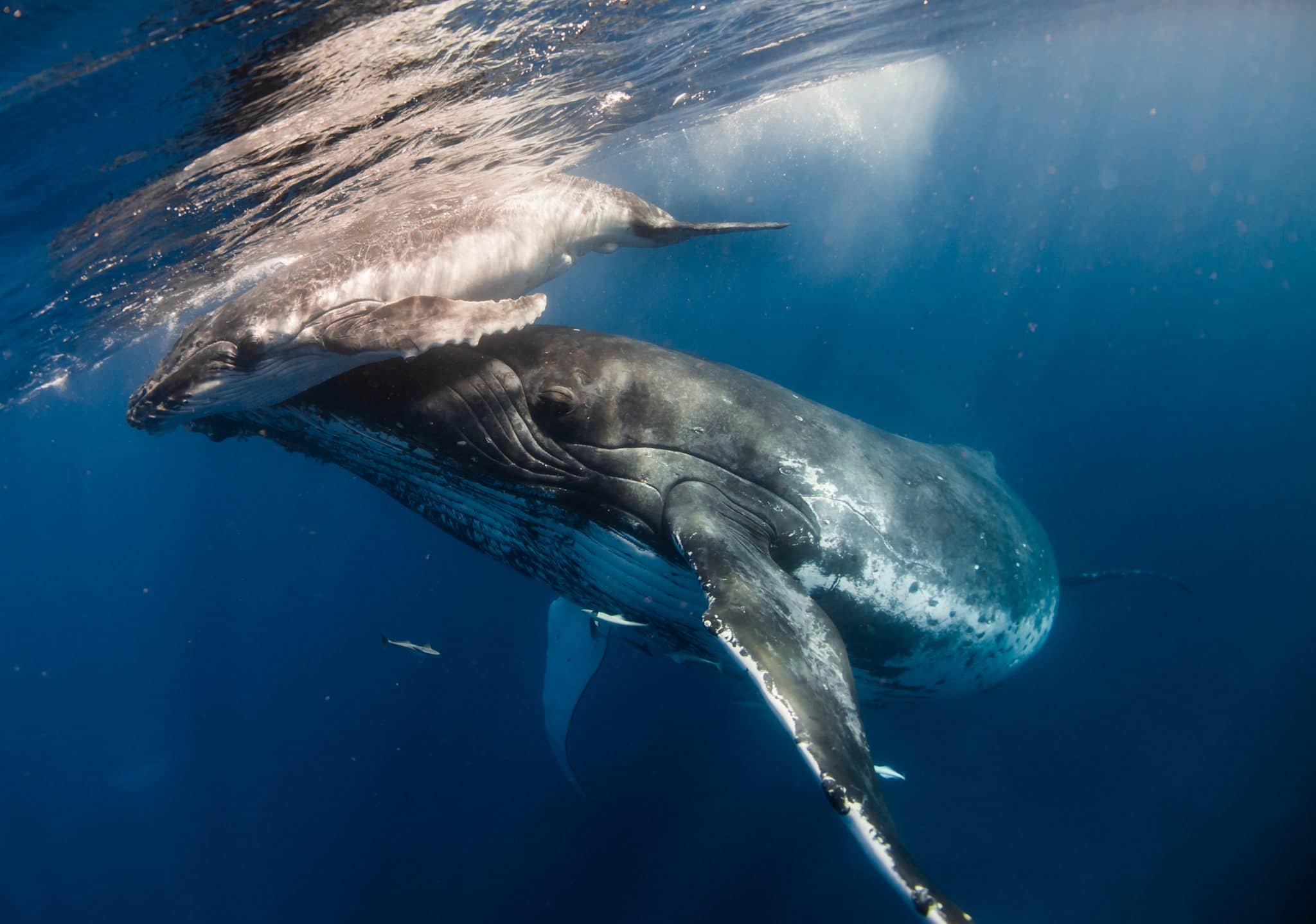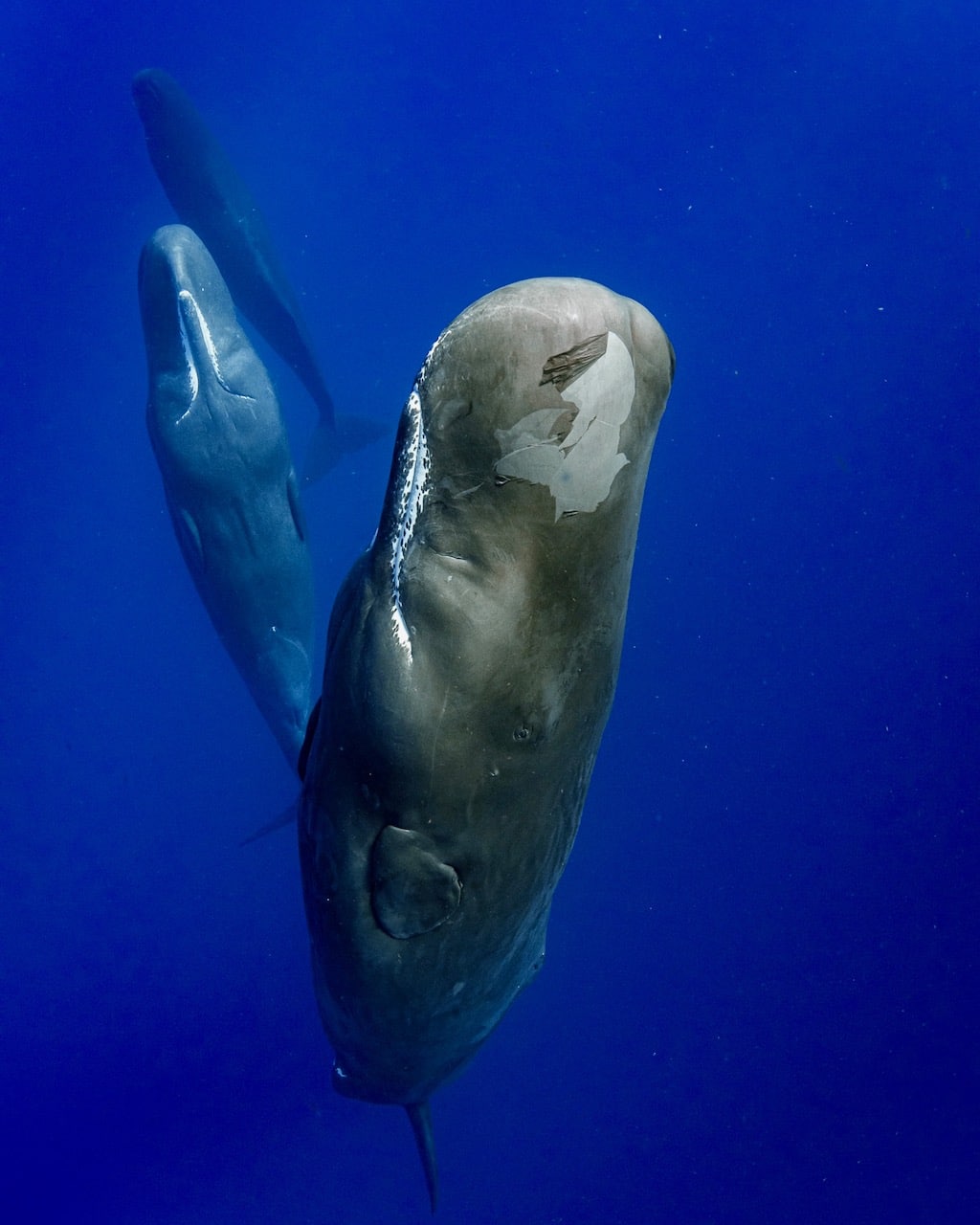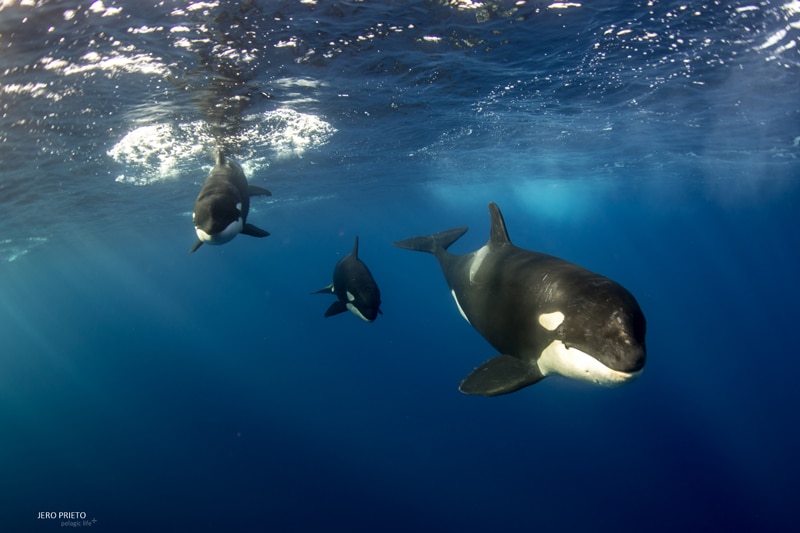Marine Life & Conservation Blogs
A Guide to Swimming with Whales

A guest blog from PADI to mark World Whale Day
There’s nothing more magical than an encounter with a gentle giant underwater. Looking into their all-knowing eyes, you’ll quickly realize you are a visitor in their world! Supporting responsible whale tourism around the world is a great way to support local conservation efforts and catch a glimpse of the ocean’s largest ambassadors.
As protected species in most of the waters of the world, often you are limited to viewing whales from afar on the deck of a boat. But if your dreams of swimming with whales run deep, then PADI, the world’s largest diving organisation with over 6,600 dive centers and resorts, can make those dreams come true.
In some parts of the world, it’s possible to not just view them from the deck of a boat, but to enter the water and responsibly swim with them – often without any dive training required!
From sperm whales to humpbacks to the charismatic orcas (who are actually dolphins but definitely deserve a spot on the list), these are the places around the world where it’s possible to meet a whale underwater. Why not celebrate this World Whale Day (Feb 20th 2022) by planning your dream adventure now.
Where to Swim with Humpback Whales
Humpbacks are famous for their mesmerizing whale songs, which can be heard by other whales many thousands of miles away. Growing 50 to 60 feet long, they are strong swimmers that can propel themselves completely out of the water and into the air (aka “breaching”). Getting their name from the small hump in front of their dorsal fin, the underside of each whale is unique in its pattern and pigmentation. Perhaps the coolest thing about humpbacks (besides their crazy water acrobatics) is that they are known to blow bubbles in order to confuse and catch fish!
Their long migrations lead them from the poles to the equator, allowing whale lovers to have close encounters along many diverse coastlines. While there are pretty tight regulations against swimming with humpbacks in much of the world, here are a few where it is legal through sustainable tourism operators.
1. Tonga: July -October
Every July through October, huge numbers of humpbacks travel north from Antarctica to Tonga to mate and calf. The best places to swim with the whales from my experience are the islands of Vava’u or Ha’apai. Only a handful of boat operators receive permits to go near the whales each year, and each boat can only take a small number of people, so booking your trip early is important.
2. Tahiti, French Polynesia: August – October
From August to October each year, humpbacks travel to Tahiti to birth their calves in the calm, warm waters off the island. Today, French Polynesia is a designated shark sanctuary and exclusive economic zone (EEZ) in order to protect its incredible marine life. Tahiti and Mo’orea are the main spots to swim with whales, offering both daily swim experience that also include the extra options of swimming in waterfalls and swimming with rays.
3. Western Australia: June – November
From June to November each year, approximately 40,000 whales migrate along the coastline of Ningaloo Marine Park, including Ningaloo Reef, in order to feed at the poles. Also referred to as Australia’s coral coast, Ningaloo is the site of a thriving coral reef which is home to other marine life including dolphins, rays, and turtles. Tours here take small groups on full day excursions to swim with the migrating whales and are designed to have little to no impact on the marine environment.
4. South Africa + Mozambique: July-October
Hundreds of humpback whales travel up the coast from Durban to Mozambique each July through October to mate and calf in the Indian Ocean. The coastal town of Tofo, which is also known for its population of whale sharks, is a great home base, where you can both snorkel and dive with the whales, as well as the countless other marine creatures that call the area home. Or you can catch them off the coast of South Africa during the infamous and epic sardine run.
5. Dominican Republic: January – April
The Dominican Republic’s Silver Bank is in a 650-square-mile marine sanctuary (now expanded as part of the “Sanctuary for the Marine Mammals of the Dominican Republic”) located about 50 miles north of the island. A large population of North Atlantic humpbacks gather here each winter and spring to mate and calf from the months of January through April. Take a week-long yacht trip to Silver Bank for the chance to to swim with the whales every day during the trip.
Where to Swim with Sperm Whales
Sperm whales are the largest of the toothed whales, as they can grow to be nearly 60 feet long, and are recognizable by their huge, rounded foreheads. They can dive down more than 3,000 feet (deeper than nearly all other whales) and hold their breath for 90 minutes, which helps them in their quest to eat giant squid and 2,000 pounds of fish per day. Female whales and their calves travel in groups of 15 to 20, while male sperm whales usually travel on their own. They are the loudest animals on the planet, as the clicking sounds they make reach such an intense frequency (more than 200 dB) that the whales can hear each other’s clicks from thousands of miles away. (To a human, sounds over 110 dB can be painful, so sperm whale sounds could blow out your eardrums!) They’re not just loud, though, but also highly intelligent. A sperm whale’s brain is approximately six times the size of a human brain, making it the largest brain of any animal on Earth! (Another fun fact: the whale in Moby Dick is a sperm whale.)
Given that they dive down so deep and can be shy, the best way to swim with them is to find a group of ‘standing’ sperm whales, which is how they sleep. Through and through, sperm whales are gentle giants who sometimes even take interest in interacting with humans.
1. Dominican Republic: Winter Months
In the winter, females and their calves can be spotted off the shores of this Caribbean island nation, which is located halfway between the islands of Guadeloupe and Martinique. Swimming with these whales requires some pre-planning: permits are required, only snorkeling is allowed, and you must be accompanied by a licensed operator.
2. Sri Lanka: February – April
Off the northern coast of Sri Lanka, sperm whales can be spotted from February to April. Tour operators need to obtain a permit from the Sri Lankan government, with the majority of tours organised as a whale watching tours. But if you get lucky enough, there are a few that focus on actually swimming with these mystical creatures.
(*fun fact: Sri Lanka is also one of the only countries in the world where you can swim with the biggest mammal in the world, the blue whale. They aren’t particularly interactive, so your best bet is to jump in the water as it passes by, like a freight train, underneath you.)
Where to Swim with Orcas
Often called killer whales, orcas are actually in the dolphin family, but they deserve a spot on this list because they’re beautiful, amazing and a once-in-a-lifetime opportunity to swim with. While known to be some of the deadliest creatures in the ocean, they are equally some of the most intelligent. They can even hunt great white sharks! Orcas travel in pods of up to 40, so if you see one, there’ll be dozens more close by.
1. Norway: October – February
From the end of October to the beginning of February, the Tromsø region in the far north of Norway is perhaps the best place to see killer whales in their natural habitat, thanks to the high concentration of herring which brings thousands of orcas (and humpbacks, too) all to one geographical location. Scuba diving typically is not necessary, as the whales remain pretty close to the surface, but snorkeling and swimming are common each winter. Luckily, the orcas are not on the hunt for anything but fish, so they won’t take any interest in you. Because an adventure like this must be so tightly planned and regulated, spots are few and planning ahead is important. Booking online is easy, though, and there are many tours and excursions to choose from.
2. Baja California Sur: All Year Long
Baja California Sur’s magical waters offer an incredible array of opportunities to swim with all sorts of marine life, including orcas. You can easily hop on an exploratory trip with PADI Dive Center Dive Ninja Expeditions with the goal of finding resident pods of orcas that live and hunt off the coastline. There are on average, three core pods of orcas that swim through these waters, making an encounter with them highly likely!
Header Image: Jay Clue / Dive Ninja Expeditions
Blogs
Saba’s Plan for a Coral Comeback

Saba has an exciting new initiative to restore its coral reefs. This new project, running from 2024 to 2026, will focus on reviving key species in the island’s underwater ecosystems. With a collaborative team from the Saba Conservation Foundation (SCF) and Van Hall Larenstein (VHL) University of Applied Sciences, the project aims to restore both corals as well as sea urchins.
This initiative is centered around coral restoration, specifically reviving two essential coral species—staghorn coral (Acropora cervicornis) and elkhorn coral (Acropora palmata). By mapping parent colonies and using a technique known as coral gardening, SCF will create and maintain coral nurseries. These corals will eventually be outplanted at key reef sites around Saba to not only expand the number of coral colonies, but also provide essential fish habitat. The project focusses on installing coral nurseries, training staff with the newest techniques and starting with the restoration of key reef sites.

Reef Cleaners to the Rescue
It’s not just corals getting a makeover—this project also shines a spotlight on the essential role of grazers, particularly sea urchins. VHL is leading the charge on cultivating and restocking two key sea urchin species, West Indian sea egg (Tripneustes) and long-spined sea urchin (Diadema), known for their ability to keep algae in check. By removing algae, which are important competitors of corals, they help the coral to thrive. By restoring these “reef cleaners,” Saba’s project will give corals the breathing room they need to grow, setting the stage for a healthier, more balanced marine ecosystem.
From Tiny Urchins to Big Goals
The project will be funded as part of the Dutch Government’s Nature and Environment Policy Plan (NEPP) 2020-2030 for the Caribbean Netherlands, a comprehensive initiative aimed at conserving and restoring the unique natural environments of the Dutch Caribbean islands, including Saba, St. Eustatius, and Bonaire. This project is aiming for big milestones: build and maintaining coral nurseries, the expansion of urchin cultivation facilities, and the creation of a dedicated research center. By 2026, the project hopes to ramp up coral and grazer restoration, with the ultimate goal of extending these efforts across the Dutch Caribbean. By linking local initiatives to broader regional goals, Saba’s restoration project promises to leave a lasting impact on both the environment and the community.
Find out more about the DCNA at dcnanature.org.
Blogs
Reef-World marks two decades of marine conservation: strengthening impact amid coral reef threats

Empowering ocean stakeholders to tackle future challenges and ensure the survival of coral reefs and humanity
2024 marks the 20th Anniversary of The Reef-World Foundation’s tireless efforts for global coral reef conservation. The UK charity is the international coordinator of the UN Environment Programme’s Green Fins initiative, known as the leading voice in sustainable marine tourism. Today, Reef-World released its 2023-2024 Impact Report outlining a year of substantive growth and impact in its marine conservation programmes.

Impact Report Highlights:
- Impressive improvements in environmental behaviours to protect coral reefs by the marine tourism industry as the global participation of Green Fins increases.
- Continued capacity building for government and NGO staff to effectively manage marine tourism activities in Asia, Caribbean and Red Sea regions.
- For the first time in Green Fins’ 20-year history, tourism operators have achieved ‘Best Environmental Performer’ status by demonstrating the lowest possible environmental impact in their environmental assessments. In 2024, three dive operators achieved this challenging milestone.
- Significant increases in global participation of Reef-World’s innovative digital conservation tools.
- 138 Green Fins dive operator members achieved the strict threshold for PADI Eco Center recognition.
- Developed four new educational materials and translated two into 16 languages to support the marine tourism industry in achieving sustainability targets.
- Establishing a new Reef-World Development strategy and recruiting new roles – Development and Programmes Managers.
- Reef-World’s board welcomes new Chair and Trustees strengthening organisational leadership.

Reef-World started as a one-person mission to inspire and empower communities to act in conserving and sustainably developing coral reefs and related ecosystems. Today, the team of 12 continues to meet this mission by inspiring and empowering the global marine tourism community to be exemplary sustainability leaders by using the Green Fins guidelines and tools to simultaneously use and protect the world’s precious reefs.
In April 2024, the fourth global coral reef bleaching event was confirmed. Reef-World’s work has never been more urgent as the marine environment, and the benefits they provide humanity, continue to be eroded by global threats. The reduction of local threats, like those from the marine tourism industry, is an essential step to ensuring a future where coral reefs survive and continue to support the millions of people who depend on their ecosystem benefits. Reef-World’s work buys time for coral reefs and related ecosystems to be resilient to the impacts of global threats.
“Right now our corals are facing the greatest fight of their existence as the terrifying predictions of the steps towards their complete extinction are starting to come true. But all is not lost, reefs are resilient and they have existed on this planet for millions of years. We must take action now, to buy time for reefs by reducing threats facing them and allowing them to react and adjust to the changing environment they need to survive in.” – Chloe Harvey, Executive Director
Looking Forwards:
Like coral reefs, the Reef-World team needs to be resilient in the face of the complex challenges of the conservation sector. Reef-World has invested significantly in developing a Culture of Care to ensure the well-being of its team on a daily basis, continuing to be an exemplary employer to enable its team to best achieve the mission for coral reef conservation.
With the foundations of a Culture of Care and organisational development laid, Reef-World is emerging from the end of a natural organisation life cycle, that brings the challenges of growth and scale, stronger than ever. With a new strategy in place to generate much needed resources, Reef-World is excited for the opportunities to leap forward, continue to scale our impact and lean into new innovations and untapped opportunities for marine conservation.
We continually strive to become a forward-thinking organisation that delivers on our goals and commitments to our stakeholders with fresh approaches and not being afraid of steering away from a “normal approach.” This approach is not only applied to our programmes of work but also internally and carries over to our Culture of Care for our team.” — JJ Harvey, Operations Director

The Reef-World Foundation is immensely grateful for the continued support of its grant funders: UN Environment Programme, IUCN’s Blue Natural Capital Financing Facility, Adventure Travel Conservation Fund, PADI Aware Foundation, and World Nomads Footprints Program.
Reef-World would also like to express its gratitude to international partners whose vital support has resulted in significant tangible benefits for our work and mission: PADI; Professional SCUBA Schools International (PSS); Explorer Ventures; 1% for the Planet; ZuBlu; Snorkel Venture, GSTC; Dive O’Clock; Seven Dragons; DiveAssure and Eco Beach, without whom these achievements would not be possible.
The full 2023–2024 Annual Impact Report is available on Reef-World’s website.
-

 News2 months ago
News2 months agoIconic SS United States to become the World’s Largest Artificial Reef
-

 News3 months ago
News3 months agoBook Review – 52 Assignments: Underwater Photography
-

 Gear News3 months ago
Gear News3 months agoDYNAMICNORD – New German diving brand enters the British market
-

 News3 months ago
News3 months agoExploring Cenote El Pit: A Diver’s Dream
-

 Gear News3 months ago
Gear News3 months agoTry BARE drysuits (and maybe even win one!) this Friday with Sea & Sea at North West Dive Fest
-

 Marine Life & Conservation3 months ago
Marine Life & Conservation3 months agoBook Review: Coral Triangle Cameos
-

 Blogs2 months ago
Blogs2 months agoDive the Egyptian Red Sea this Autumn with Regaldive
-

 News3 months ago
News3 months ago2024 Ocean Art Underwater Photo Competition Announced


















